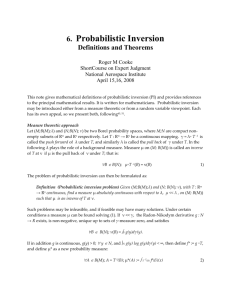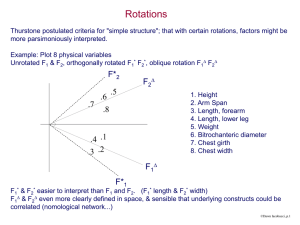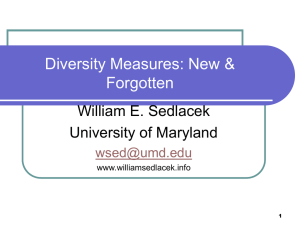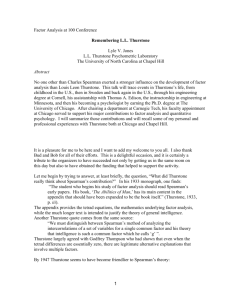Coefficient of agreement - Applied Mathematics
advertisement
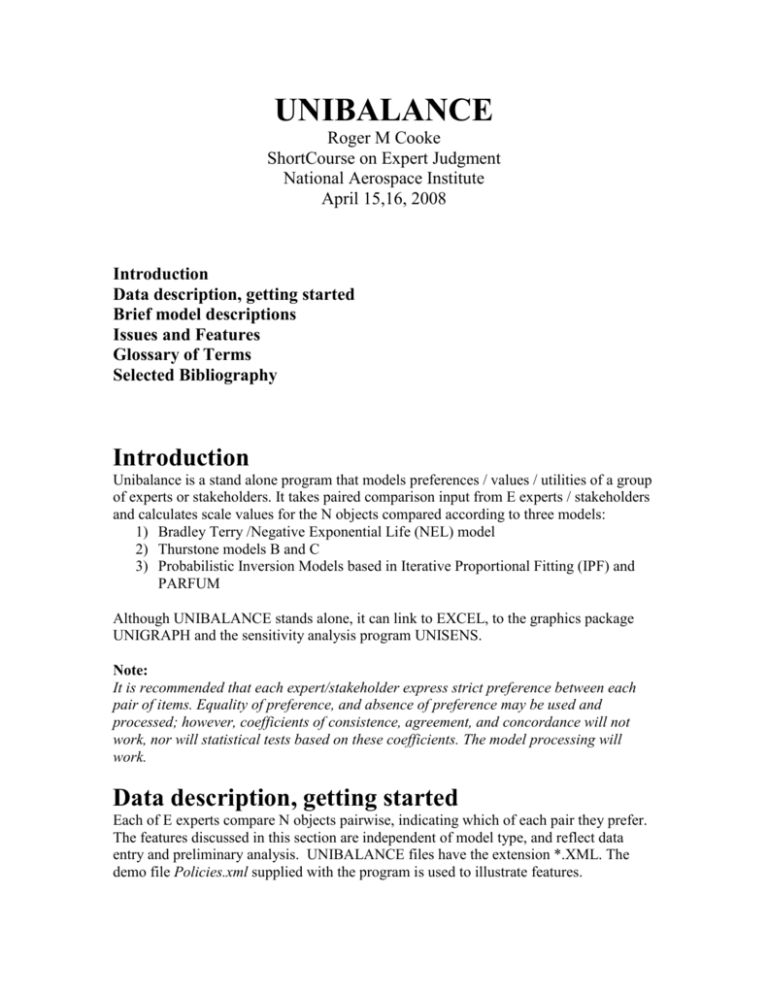
UNIBALANCE
Roger M Cooke
ShortCourse on Expert Judgment
National Aerospace Institute
April 15,16, 2008
Introduction
Data description, getting started
Brief model descriptions
Issues and Features
Glossary of Terms
Selected Bibliography
Introduction
Unibalance is a stand alone program that models preferences / values / utilities of a group
of experts or stakeholders. It takes paired comparison input from E experts / stakeholders
and calculates scale values for the N objects compared according to three models:
1) Bradley Terry /Negative Exponential Life (NEL) model
2) Thurstone models B and C
3) Probabilistic Inversion Models based in Iterative Proportional Fitting (IPF) and
PARFUM
Although UNIBALANCE stands alone, it can link to EXCEL, to the graphics package
UNIGRAPH and the sensitivity analysis program UNISENS.
Note:
It is recommended that each expert/stakeholder express strict preference between each
pair of items. Equality of preference, and absence of preference may be used and
processed; however, coefficients of consistence, agreement, and concordance will not
work, nor will statistical tests based on these coefficients. The model processing will
work.
Data description, getting started
Each of E experts compare N objects pairwise, indicating which of each pair they prefer.
The features discussed in this section are independent of model type, and reflect data
entry and preliminary analysis. UNIBALANCE files have the extension *.XML. The
demo file Policies.xml supplied with the program is used to illustrate features.
On start up, the basic menu structure is shown on the left panel:
1) Assign the project a name and enter an appropriate description.
2) Enter the item names by Highlighting Items. If true values for some items are
know, they may be entered as well. These can be used to calibrate the Bradley
Terry and Thurstone models. When names are entered, a “+” appears by the Item
menu, indicating that this can be expanded.
3) Enter the expert names and any description to be used in the report, by
highlighting Experts. A “+” appears by the Expert and Matrices fields, indicating
that these can be expanded.
4) Expand the Matrices field. Double click on an expert’s matrix. For each cell
(row,col), enter
a. > if the row item is strictly preferred to the column item
b. < if the column item is strictly preferred to the row item
c. = if the preference between row and column items is equal
d.
(empty) if the preference is not filled in.
“=” and “ “ should be avoided if possible. The screenshot below shows the matrix of
expert 15, Ronny:
The p-value at which we would reject the hypothesis that Ronny filled in his preferences
at random, is 0.2080, too high for rejection. This test is based on the number of circular
triads (see glossary below) which one would expect if the preferences were indeed at
random. The coefficient of consistence measures the degree of consistency (that is,
absence of circular triads, see glossary below). The value 1 is perfectly consistent, and
zero is maximally inconsistent. It must be stressed that these measures are derived under
the assumption that all preferences are strict. When equal or void preferences are
admitted, they should be viewed as indicative.
Brief model descriptions
When the data has been entered, the models can be analyzed.
Bradley Terry
It is assumed that each item i has a value V(i) to be estimated from the paired comparison
data. The percentage of experts %(i,j) who prefer item i to item j, estimates of the
conditional probability of drawing an expert from the population of experts who prefers i
to j, given that (s)he must choose between i and j. It is assumed that this probability is
equal to V(i)/[V(i)+V(j)]. The model is solved by maximum likelihood. Assuming that
each expert for each comparison is drawn independently from the expert population, the
lielihood of the data is
all pairs (i,j) [V(i)/(V(i)+V(j))]E%(ij) [V(j)/(V(i)+V(j))]E%(j,i).
The circumstance that each expert assess all pairs of items approximates the will
approximately satisfy this assumption as the number of experts gets large. Values are
sought which make the above expression as large as possible. Evidently, a solution
V(1)...V(N) is determined only up to a positive multiplicative constant. If one of the V(i)
is known, the other values are uniquely determined.
Negative exponential lifetime model
This model is computationally identical to the Bradely Terry model, though the
interpretation is different. It is assumed that the item i is a component with exponential
life distribution, and with failure rate i, i = 1,...N. For all pairs of objects, each subject is
asked to determine which component has the greater probability of failing per unit time.
In answering each such question, it is assumed that each subject performs a "mental
experiment", observing which of two independent exponential components with failure
rates i, j fails first. Under these assumptions the probability pij that i fails before j is
given by:
j
pij =
i + j
.
The percentage of experts preferring i to j is taken to estimate pij. The above system of
equations is overdetermined, and the principle of maximal likelihood may be used to
solve for the i's. Multiplying each failure rate in the above equation by a constant would
leave the equations invariant, hence the resulting i's are determined only up to a
constant. If one of the i is known, (reference value) the others may be determined from
the maximum likelihood solution.
Thurstone models
It is assumed that a subject comparing two objects i and j effectively samples two normal
random variables Xi and Xj with means and standard deviations i, i, j, j. Item i is
preferred to j if and only if Xi - Xj > 0. It is further assumed that all experts sample the
same normal variables. The model is sometimes explained as follows: each item i has a
“true value” i; each expert perceives this value with an “error” i.
The variable Xij = Xi - Xj is normal with mean mij and standard deviation sij:
ij = i - j
ij = (i2 + j2 - 2ijij)
where ij is the correlation between Xi and Xj. The percentage %(ij) of experts preferring
i to j estimates the probability that Xij is positive, or equivalently, that
(Xij- ij)/ ij > -ij/ij.
Letting Φ denote the cumulative standard normal distribution function, and
let Φ-1 denote its inverse. We derive Thurstone's law of comparative judgments:
Φ-1(%(ij)) ~ ij/ij = (i - j)/ij.
Note that the law of comparative judgments is invariant under positive affine
transformations of all variables. That is, if for each i, Xi is replaced by a positive affine
transform Xi' = aXi + b, a > 0, then ij'/ij' = ij/ij. This means that paired comparison
data can determine the values of the i only up to a positive affine transformation, and the
values of i only up to a linear transformation.
Considered as a system of equations, the law of comparative judgments contains more
unknowns than knowns, and hence cannot be solved. However, under various ssumptions
it is possible to determine the means mi up to a positive affine transformation, i.e. up to a
choice of zero and unit.
Thurstone C
In this model it is assumed that ij = (i.e. does not depend on i and j). For all practical
purposes this equivalent to assuming that ij = 0 and i = /2. Filling these into
Thurstone's law, and recalling that the Xi are determined only up to an affine
transformation, Thurstone's law becomes simply:
i - j = Φ-1(%(ij))
A least squares routine is used to determine the mi up to a positive affine transformation.
Thurstone B
Thurstone’s model B is computed and displayed under “Results” but confidence intervals
for this model are not supported.
In this model it is assumed that for all i ≠ j.
ij = ,
|i - j| << i.
Under these conditions we can derive
i - j = Φ-1(%(ij))(1-) (i + j) / 2.
Since the units of the Xi are arbitrary, we can write this as
i - j = Φ-1(%(ij))(i + j).
which is equivalent to assuming ij = -1 in Thurstones law of comparative judgments.
With N objects, there are N CHOOSE 2 such equations with 2N unknowns. For N > 5
there are more equations than unknowns. We find a least squares solution for the mi,
unique up to a positive affine transformation.
Confidence intervals
Confidence intervals are simulated for the Thurstone C linear and the NEL models. The
procedure is roughly as follows:
1. The model is solved using the expert data and reference values. This yields values for
the model parameters mi (Thurstone C) or i (NEL).
2. Expert responses are simulated by appropriately sampling distributions with the model
parameter values emerging from step 1.
3. The model is solved again, using the expert preference data emerging from step 2, and
the initial reference values. The results are stored.
4. Steps 2 and 3 are repeated 500 times for each model and 90% central confidence bands
are extracted and displayed.
Probabilistic Inversion
Probabilistic inversion denotes the operation of inverting a function at a (set of)
distributions, and it constitutes a different approach to utility quantification than the
Bradley Terry or Thurstone models. This model involves one very mild assumption,
which, in combination with a choice of starting “non-informative” starting distribution,
yields an estimate of the joint distribution of utility scores over the population of experts.
Assumption: There are two alternatives, not necessarily included in the set of items, for
which all experts agree that one of these is strictly preferred to the other and that all
items are between these two in preference.
That is, we can find two alternatives, say “very very good” and “very very bad” which
everyone agrees are strictly better and worse respectively, than the items of study.
Decision theory teaches that all utility functions are unique up to a positive affine
transformation, that is, up to a choice of 0 and unit. With the above assumption, we may
assume that all experts’ utilities are normalized to the [0, 1] interval.
Starting distribution: The starting distribution is a sample from product uniform
distribution [0,1] N.
The size of the sample for the starting distributions is controlled under the “Options” field
for probabilistic inversion. With N items, we start by assuming that the population of
experts’ utilities are independently uniformly distributed on the [0, 1] interval for each
item.
We now want to ‘minimally perturb’ the starting distribution so as to comply with the
expert preferences. That is if U1,…UN is a vector of utilities drawn from the perturbed
distribution, then for each i, j, the following constraint is satisfied:
the probability Ui > Uj = percentage %(i,j) of experts who preferred i to j.
Two algorithms are available to accomplish this. Iterative Proportional Fitting (IPF)
finds the maximum likelihood distribution satisfying the expert preference constraints,
relative to the starting distribution IF the problem is feasible. The problem may not be
feasible; that is, there may be no distribution on [0, 1]N satisfying the above constraint. In
this case IPF does not converge.
Infeasibility is rather common in this context, as there are a very large number of
constraints. In such cases we seek a distribution which is ‘minimally infeasible’. This can
be found with the PARFUM algorithm. If the problem is feasible, the PARFUM
algorithm returns a solution which is close to, but not equal to, the IPF solution. If the
problem is infeasible PARFUM converges to a distribution which ‘distributes the pain’
equally over the constraints, in an appropriate information sense. Parfum takes much
longer to converge.
For the 6 policies case, the “proportion matrix” showing the target preference
probabilities (black) and the preference probabilities realized by IPF (gray) after 100
iterations. They are identical up to 4 decimals. This problem is feasible.
The proportion matrix for PARFUM after 1000 iterations is shown below:
There are still substantial differences, the largest of which are highlighted. 5000
iterations are required to achieve the same accuracy as with 100 IPF iterations.
The correlation matrix for the utilities of the items is shown below for the IPF solution
(10000 iterations):
Note that these correlations are not identical. If we draw a ‘random expert’ the utility
values for items 2 and 6 are correlated with 0.2817, whereas the values for items 2 and 1
are practically uncorrelated.
The results of the various models can be compared from the Results field, as shown
below:
For the Thurstone and PI models, the option of rescaling the utility values so that the
highest is 1.000 and the lowest is 0 is available. These are called standardized scores, and
they facilitate model comparisons. Standardization is not meaningful for the Bradley
Terry model, as these are not measured on an affine scale, but on a ratio scale.
From the “Tools generate report” menu option, a report can be generated with all input
and output.
Issues and Features
UNIBALANCE has a few warts and blemishes, which however are easily worked around
1. Error messages: these are placed on a balk which is only visible if run full screen
2. file management: the first time UNIBALANCE is run, it creates a subdirectory
SIMULATION in the directory where UNIBALANCE lives. That is by default
the locus of all output files. Results are stored in files named file.*. file.sam is an
ascii file read by UNIGRAPH and UNISENS. File.prb is a list of probabilities for
resampling file.sam. Normally you have no use fot this file. File.txt is a space
separated ascii file which you can open with EXCEL.
3. UNIGRAPH is called by UNIBALANCE after the file location has been entered
in the OPTIONS field. However, you will have to open file.sam manually from
UNIGRAPH. Alternatively, open UNIGRAPH directly, not via UNIBALANCE,
and it will remember the last visited directory.
4. Entering Data: items and experts cannot be deleted once entered. If you enter
items and forget to hit “OK” you don’t see the number if items indicated. If you
go back and re-enter the items, the old ones re-appear as “item 1,..” and cant be
eliminated. Start over. Similar remarks hold for experts.
5. Preference matrix in Summary field: the p-value refers to the coefficient of
agreement. These coefficients should only apply when all preferences are strict.
6. Can’t open file: if UNIGRAPH is open, you cannot write another file.sam.
7. Tolerance: stops the iterative algorithms when a prescribed absolute difference
between successive iterates is achieved. When tolerance = 0, a non convergence
message will always appear. Tolerance is given in multiples of 10-15, but only 7
digits are shown in the corresponding fenster.
Glossary of Terms
Circular Triads
A circular triad obtains in the preferences of an expert for items i,j,k if i > j, j > k, and k
> i. Too many circular triads in an expert’s data is an indication that his preferences are
being “drawn at random”, or that the items are indistinguishable. Simple computations
and tests are available when all preferences are strict. Letting ai denote the number of
times that item i is (strictly) preferred to some other item, the number of circular triads in
the response data for a given expert is
CT
T (T 2 1) C
24
2
Where C =
2
T
ai
T
ai i 1
T
i 1
If the number of items T < 7, we obtain the p-value of the hypothesis that the expert
specifies his preference randomly from the tables (e.g. Table10C from Kendall (1975)).
For more than 7 items, Kendall showed that the transformed number of circular triads is
2 distributed with d degrees of freedom:
T (T 1)(T 2)
d
(T 4) 2
2
8 1 n
1
CT d
n 4 4 3
2
Based on these equations we are able to test the hypothesis that the expert specified his
preferences randomly. We would like to reject this hypothesis. If the p value is above,
say, 0.05, then the ‘at-random’ hypothesis would not be rejected. In this case we could
consider dropping the expert.
Coefficient of consistence
We can also introduce the coefficient of consistence ζ. It reaches the maximum value 1 if
there are no inconsistencies in the data, which implies that the output of comparison
process might be expressed as a ranking. The value decreases if the number of circular
triads increases. The lowest value of ζ is 0.
24 CT
, if number of items is odd
T (T 2 1)
24 CT
1
, if number of items is even
T (T 2 4)
1
Coefficient of agreement
Let E be the number of experts, N the number of object is to be compared, and a(ij) the
number of experts who prefer object i to j. Define "A CHOOSE B"
as the binomial coefficient A!/(B!(A-B)!), and define
= i≠j (a(ij) CHOOSE 2)
The coefficient of agreement u is defined as
2
u = - 1.
(E CHOOSE 2) * (N CHOOSE 2)
u attains its maximal value, 1, when there is complete agreement. u can be used to test the
hypothesis that all agreements are due to chance (see Experts in Uncertainty chapter 14).
The coefficient of agreement is not diminished for lack of consistency in the experts; if
there are 3 items and all say 1 > 2 > 3 > 1, then u = 1.
Coefficient of concordance
Let R(i,e) denote the rank of object i for expert e, where the rank is determined by the
number of times e prefers i to some other object. Define
R(i) = e=1..ER(i,e)
S = i=1..N[(R(i) - (1/N) i=1..N R(j)]2
The coefficient of concordance w is defined as
S
w = .
E2*(N3-N)/12
w attains its maximal value, 1, when there is complete agreement, and can be used to test
the hypothesis that all agreements are due to chance (see Experts in Uncertainty, chapter
14). If for three items, all experts say 1 > 2 > 3 > 1, then S = 0.
Iterative proportional fitting
This algorithm finds a distribution which is minimally informative (and thus maximum
likely) relative to a starting distribution and which satisfies finitely many marginal
constraints. The algorithm works by cyclically adapting the starting distribution to each
constraint. If a distribution satisfying the constraints exists, which is absolutely
continuous with respect to the starting distribution, then IPF converges rapidly.
PARFUM
The PARFUM algorithm is a variant on the IPF algorithm. Instead of cycling through the
constraints, a starting distribution is adapted to each constraint individually, and these
distributions are then averaged to form the next iteration. PARFUM always converges,
and if the problem is feasible, it converges to a solution which is close to, though not
identical with, the IPF solution.
Selected Bibliography
1. Anderson, S.P., A. de Palma and J-F Thissen, 1996 Discrete Choice Theory of
Product Differentiation, MIT Press, Cambridge.
2. Bradley, R. (1953) “ Some statistical methods in taste testing and quality
evaluation” Biometrica, vol. 9, 22-38.
3. Bradley, R. and Terry, M. (1952) “Rank analysis of incomplete block designs
Biometrica, vol. 39, 324-345.
4. Cooke R. M. and Misiewicz, J. 2007 Discrete Choice with Probabilistic
Inversion: Application to energy policy choice and wiring failure, Mathematical
Methods in Reliability.
5. Csiszar I. 1975 I-divergence geometry of probability distributions and
minimization problems. Ann. of Probab., 3:146-158.
6. Deming, W.E., and Stephan, F.F. 1944. On a least squares adjustment to sample
frequency tables when the expected marginal totals are known, Ann Math. Statist.
40, 11, 427-44.
7. Du, C. Kurowicka D. and Cooke R.M. 2006 Techniques for generic probabilistic
inversion, Comp. Stat. & Data Analysis (50), 1164-1187.
8. Environmental Security in Harbors and Coastal Areas Likeov I,. Kiker, G.A. and
Wenning, R.J. (eds) Springer, dordrecht, 2007
9. French, S. (1988) Decision Theory; an Introduction to the Mathematics of
rationality Ellis Horwood, Chichester.
10. Halpern, B.S., K.A. Selkoe. F. Micheli, and C.V. Cappel. 2007. Evaluating and
ranking global and regional threats to marine ecosystems. Conservation Biology
21:1301-1315
11. Ireland C.T. and Kullback. S. 1968 Contingency tables with given marginals.
Biometrika, 55:179-188.
12. Kraan B.C.P. and Cooke. R.M. 2000 Processing expert judgements in accident
consequence modeling. Radiation Protection Dosimetry, 90(3):311-315.
13. Kraan B.C.P. and Cooke. R.M. 2000 Uncertainty in compartmental models for
hazardous materials - a case study. J. of Hazardous Materials, 71:253-268.
14. Kraan, B.C.P and Bedford. T.J. 2005 Probabilistic inversion of expert
judgements in the quantification of model uncertainty. Management Science,
51(6):995-1006.
15. Kraan. B.C.P. 2002 Probabilistic Inversion in Uncertainty Analysis and related
topics. PhD dissertation, TU Delft, Dept. Mathematics.
16. Kruithof J.. Telefoonverkeersrekening. De Ingenieur, 52(8):E15{E25, 1937.
17. Kullback S. 1959 Information theory and Statistics. John Wiley and Sons, New
York.
18. Kullback S. 1968 Probability densities with given marginals. The Annals of
Mathematical Statistics, 39(4):1236{1243.
19. Kullback S. 1971 Marginal homegeneity of multidimensional contingency tables.
The Annals of Mathematical Statistics, 42(2):594-606.
20. Kurowicka D. and Cooke R.M. 2006. Uncertainty Analysis with High
Dimensional Dependence Modelling. Wiley.
21. Linkov, I., Sahay, S. Kiker, G. Bridges, T. Belluck, D. and Meyer, A. (2005)
“Multi-criteria decision analysis; comprehensive decision analysis tool for risk
management of contaminated sediments”
22. Luce R. D. and P. Suppes, 1965, Preference, Utility, and Subjective Probability. In
Handbook of Mathematical Psychology, vol. 3, ed. R. D. Luce, R. Bush, and E.
Calanter. New York, Wiley.
23. Luce, R. D. 1959, Individual Choice Behavior; A Theoretical Analysis. New York,
Wiley.
24. M.E.A. (Millennium Ecosystem Assessment). 2005. Ecosystems and Human
Well-Being: Synthesis Report. Washington, D.C.
25. Matus, F. 2007 On iterated averages of I-projections, Statistiek und Informatik,
Universit”at Bielefeld, Bielefeld, Germany, matus@utia.cas.cz.
26. McFadden, D. (1974) "Conditional logit analysis of qualitative choice behavior"
in Zarembka, P (ed) Frontiers in Econometrics, New York Academic Press,
USA, 105-142.
27. Siikamäki, J. and D. F. Layton, 2007 Discrete Choice Survey Experiments: A
Comparison Using Flexible Methods, Journal of Environmental Economics and
Management, Vol. 53, pp. 127-139.
28. Thurstone, L. (1927) “A law of comparative judgment” Pschyl. Rev. vol. 34, 273286.
29. Torgerson, W. (1958) Theory and Methods of Scaling, Wiley, New York.
30. Train K.E. 2003 “Discrete Choice Methods with Simulation” Cambridge
University Press.
31. Train, K. 1998 Recreation Demand Models with Taste Differences over People,
Land Economics 74: 230-39.
32. Vomlel,J 1999 Methods of Probabilistic Knowledge Integration Phd thesis Czech
Technical University, Faculty of Electrical Engineering.
